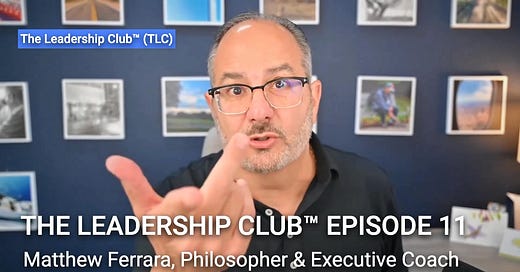(Only seeing the short clip? Be sure to sign-in to your TLC account to keep watching.)
Coaching Call #11 — June 17, 2024
In this week’s coaching call, we discussed:
Two “worksheets” to help agents balance listing-to-sales mix for growth, and lower burnout. Download the Risk Assessment and Listing Pipeline e-book: Simple Math for Real Estate Sales Success! (below)
The need to train agents on pricing, price reduction and listing-marketing techniques that a “balanced” marketplace requires.
Matching communication styles to the audience needs to generate awareness, understanding and action.
Here’s the recording, session notes and resources. If you have questions, let me know in the comments or by email.
Quick Takes:
Many agents need to shift business strategy as markets remain seller-centric, and buyer-agency issues evolve through the rest of the year.
Some salespeople may never have trained on pricing conversations, price reductions, staging, open houses or other activities that previous hot markets in the last 5-7 years created. Dust off those “essential skill” workshops and start training again!
Listing presentations and consumer conversations benefit from the “Learning Wheel” methodologies that we use in training. Check out your Leadership Handbook (download here).
Generating awareness for change recognizes that people fall into multiple levels of attention and knowledge; adjust communications efforts to handle both.
The full Coaching Call recordings and materials are available to upgraded subscribers. To enjoy The Leadership Club™ at its best, upgrade today!
Last week’s newsletter about the Simple Math
Review of Worksheets to Encourage Listing Agents
This week we reviewed two worksheets from the ebook, Simple Math for Real Estate Sales Success! The key messages to convey are:
Your sale strategy must match market conditions, which remain seller-centric. Buyers “may or may not” turn into closed deals in the next 90 days, but a listing taken today most certainly will, even if days on market increase significantly.
Effective salespeople avoid competition crowding, which is seeking too few deals amongst too many competitors. That’s the current situation in low-inventory markets, where 70-80% of agents remain buyer-centric. Avoid fishing in the “crowded section” of the pond, while only 20% of agents pursue listings with lower competition.
Create a multi-million dollar pipeline can be done on two appointments per week. Even an average performer closes enough presentations to build a 30-42 deal pipeline that has a 90% listing-to-sales conversion rate.
These worksheets make excellent office meeting, workshops and coaching tools. Download the answer keys under “More Materials” below.
Teaching Pricing Conversations and More
Effective leaders realize many of salespeople haven’t had the experience of a “balanced” marketplace in years. The past 5 years have enjoyed a rising-price, low-inventory, high-velocity environment. Price reduction conversations were rare. Staging, videography and even professional photography was hardly needed, let alone multiple open houses or prolonged advertising costs.
Markets are changing. So leaders must change, too. Follow these steps to prepare your people for the future market:
Review pricing skills with agents, including generating proper CMAs, price adjustments, and communicating recent data on sales, expireds and withdrawns.
Teach salespeople to help sellers examine their homes with the buyer’s eyes. Do this virtually with online listings and videos, although some agents take sellers to tour competing homes before setting prices. Help sellers directly experience their competition at lower, similar and higher price points.
Remind agents of the keys to an effective listing strategy: location, price, condition and terms. You cannot change location, but you can affect the other three factors. So price is only one of three levers sellers use to create competitive standing to attract buyers.
Practice handling questions, objections and consumer education with training, role-plays and interactive video. Demonstrate an excellent presentation for new agents; ask experienced agents to discuss tough questions on panels. Revive mentorship programs so inexperienced agents can learn “in the field” with capable salespeople.
Using the Learning Wheel
Remind salespeople of the educational component of presentations with sellers. There’s more than expressing your services and market spreadsheets (especially since most consumers aren’t data-centric but are emotionally invested).
The Learning Wheel reminds us to:
Explain why the listing strategy matches consumer needs, goals and market conditions. Discuss why different approaches position the home properly, and why commission can depend upon the time it takes to sell, where miss-pricing creates more expenses that must be covered.
Explain what the listing components are (see above, four levers) and the process of analyzing market data. Give consumers information, knowledge and insights to make a decision, as well as advice and benefits of your experience.
Create a participatory process in pricing; get sellers involved in applying market information being shared, not just an accept or decline choice.
Describe the future impact of decisions, by explaining the what-if scenarios that will likely occur if current (or alternate) decisions are followed.
You can find the full Learning Wheel explanation and usage
in The Leadership Handbook
More Materials👇
Here are the Worksheet answer keys, additional tools and insights into effective awareness campaigns for your company, MLS or Association.
Download the full e-book including worksheets, seller-prospecting checklist, and sources of appointments
Click and print the “answer keys” to the worksheets. Watch/Listen to the recording for the walk-through script (step-by-step with each worksheet).


[Video] A more in-depth webinar featuring Simple Math
Watch this webinar from our Always Inspiring newsletter where we talk about the whole process, as well as finding 11+ sources of seller leads for appointments.
Creating Effective Awareness Campaigns
This week an important topic was raised by a TLC member who leads a major MLS organization — that applies to all TLC members from a small office or a multi-national franchise:
How do we get everybody to become more aware of the major changes happening in our industry?
We’re a complex business: Some agents have been aware of these changes for months and years (the lawsuits were filed in 2019). Others don’t attend office meetings/Zooms and may be hearing about these things just now (although it has been all over the news…).
Nonetheless, as a leader, your job is to reach them all. Here are a few tips to help:
Recognize that gaining awareness is different than becoming informed. When reaching people for the first time, don’t concentrate on what they don’t know — focus on what they don’t know. Use techniques to help them realize there’s something to pay attention to first, with direct and indirect tools (see next).
While you can directly tell people something is happening, you also need to lead people to discover it for themselves. (This often sticks much better). Use a-ha-based techniques to help see for themselves something important. A quick quiz, a video with a “twist” ending, and stories that grab emotions help people to become more alert first.
When you have their attention, provide information in various formats. Your audience is full of every sort of learner, so accommodate different learning styles. Create content that can be watched, listened to, read, interacted with, played with, and applied. Build job aids, checklists, games and white papers - and multimedia versions of these, too.
Change distribution methods often to create “newness” even while repeating content. If you told a story during a meeting, record it and send it out again later; then transcribe it, turn it into a PDF, and break it into pieces you can text. (Sound familiar? Very much like what we do with the TLC Coaching Call transcripts.)
Create tripwires to interrupt habits. For example, if someone logs into your systems daily, put a pop-up in between their login and dashboard. If it’s vital enough, create a barrier to something desirable - such as renewing a license or being paid - until they validate they’re addressing the issue.
Use competitions, games and rewards. People engage more when they are encouraged rather than required to change.
Set a reasonable goal: You’ll never reach everyone, but you can reach most of them. So don’t give up, but don’t feel too bad if some people don’t hear about things until the last minute. You can only do so much as a leader.
Miss a Coaching Call? You can catch up anytime!
Here are some quick links to previous Coaching Calls where we talked about:
❤️ TLC Do you need additional help? Here’s how to reach it:
Matthew Ferrara (Las Vegas / PST timezone)
- email: matthew@mflearn.com
Amber Morgan, Executive Assistant (East Coast / EST timezone)
- email: amorgan@matthewferrara.com
















